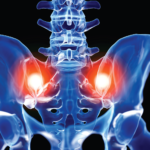Regarding future directions, Dr. Deodhar was pleased to share that the Assessment in Ankylosing Spondylitis (ASAS) working group and Group for Research and Assessment of Psoriasis and Psoriatic Arthritis (GRAPPA) are collaborating to develop formal axPsA classification criteria in the Axial Involvement in Psoriatic Arthritis Cohort (AXIS).13
“Studies to ‘molecularly’ characterize axPsA vs. PsA patients have also commenced,” he said.
Summary
Some of the differences between axSpA and axPsA have clinical and therapeutic implications, although the burden of disease for patients is similar. Work to create formal axPsA classification criteria is underway, as are therapeutic clinical trials targeted specifically to axPsA patients. It’s critical to remember to assess for axial involvement in PsA patients, given its prevalence and morbidity.
Samantha C. Shapiro, MD, is an academic rheumatologist and an affiliate faculty member of the Dell Medical School at the University of Texas at Austin. She received her training in internal medicine and rheumatology at Johns Hopkins University, Baltimore. She is also a member of the ACR Insurance Subcommittee.
References
- Jurik AG. Imaging the spine in arthritis—a pictorial review. Insights Imaging. 2011 Apr;2(2):177–191.
- Helliwell PS, Hickling P, Wright V. Do the radiological changes of classic ankylosing spondylitis differ from the changes found in the spondylitis associated with inflammatory bowel disease, psoriasis and reactive arthritis? Ann Rheum Dis. 1998 Mar;57(3):135–140.
- Poddubnyy D, Jadon DR, van den Bosch F, et al. Axial involvement in psoriatic arthritis: An update for rheumatologists. Semin Arthritis Rheum. 2021 Aug;51(4):880–887.
- Hanly JG, Russell ML, Gladman DD. Psoriatic spondyloarthropathy: A long term prospective study. Ann Rheum Dis. 1988 May;47(5):386–393.
- Benavent D, Plasencia C, Poddubnyy D, et al. Unveiling axial involvement in psoriatic arthritis: An ancillary analysis of the ASAS-perSpA study. Semin Arthritis Rheum. 2021 Aug;51(4):766–774.
- Baeten D, Østergaard M, Wei JCC, et al. Risankizumab, an IL-23 inhibitor, for ankylosing spondylitis: Results of a randomised, double-blind, placebo-controlled, proof-of-concept, dose-finding phase 2 study. Ann Rheum Dis. 2018 Sep;77(9):1295–1302.
- Deodhar A, Gensler LS, Sieper J, et al. Three multicenter, randomized, double-blind, placebo-controlled studies evaluating the efficacy and safety of ustekinumab in axial spondyloarthritis. Arthritis Rheumatol. 2019 Feb;71(2):258–270.
- Siebert S, Millar NL, Mcinnes IB. Why did IL-23p19 inhibition fail in AS: A tale of tissues, trials or translation? Ann Rheum Dis. 2019 Aug;78(8):1015–1018.
- Helliwell P, Gladman DD, Poddubnyy D, et al. Efficacy of guselkumab, a monoclonal antibody that specifically binds to the p19-subunit of IL-23, on endpoints related to axial involvement in patients with active PsA with imaging-confirmed sacroiliitis: Week-24 results from two phase 3, randomized, double-blind, placebo-controlled studies [OP0054]. Ann Rheum Dis. 2020;79(Suppl 1).
- Helliwell PS, Gladman DD, Chakravarty SD, et al. Effects of ustekinumab on spondylitis-associated endpoints in TNFi-naïve active psoriatic arthritis patients with physician-reported spondylitis: Pooled results from two phase 3, randomised, controlled trials. RMD Open. 2020 Feb;6(1):e001149.
- Deodhar A, Gladman D, Bolce R, et al. Ixekizumab efficacy in patients with psoriatic arthritis presenting with symptoms indicative of axial involvement [abstract 1347]. Arthritis Rheumatol. 2021 Oct;73 (suppl 10).
- Baraliakos X, Gossec L, Pournara E, et al. Secukinumab in patients with psoriatic arthritis and axial manifestations: Results from the double-blind, randomised, phase 3 MAXIMISE trial. Ann Rheum Dis. 2021 May;80(5):582–590.
- Poddubnyy D. Axial involvement in psoriatic arthritis cohort (AXIS) [NCT04434885]. ClinicalTrials.gov. 2020 Jun 17.



